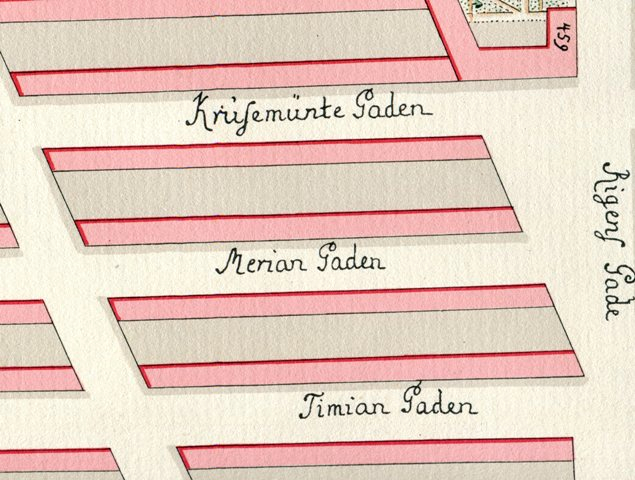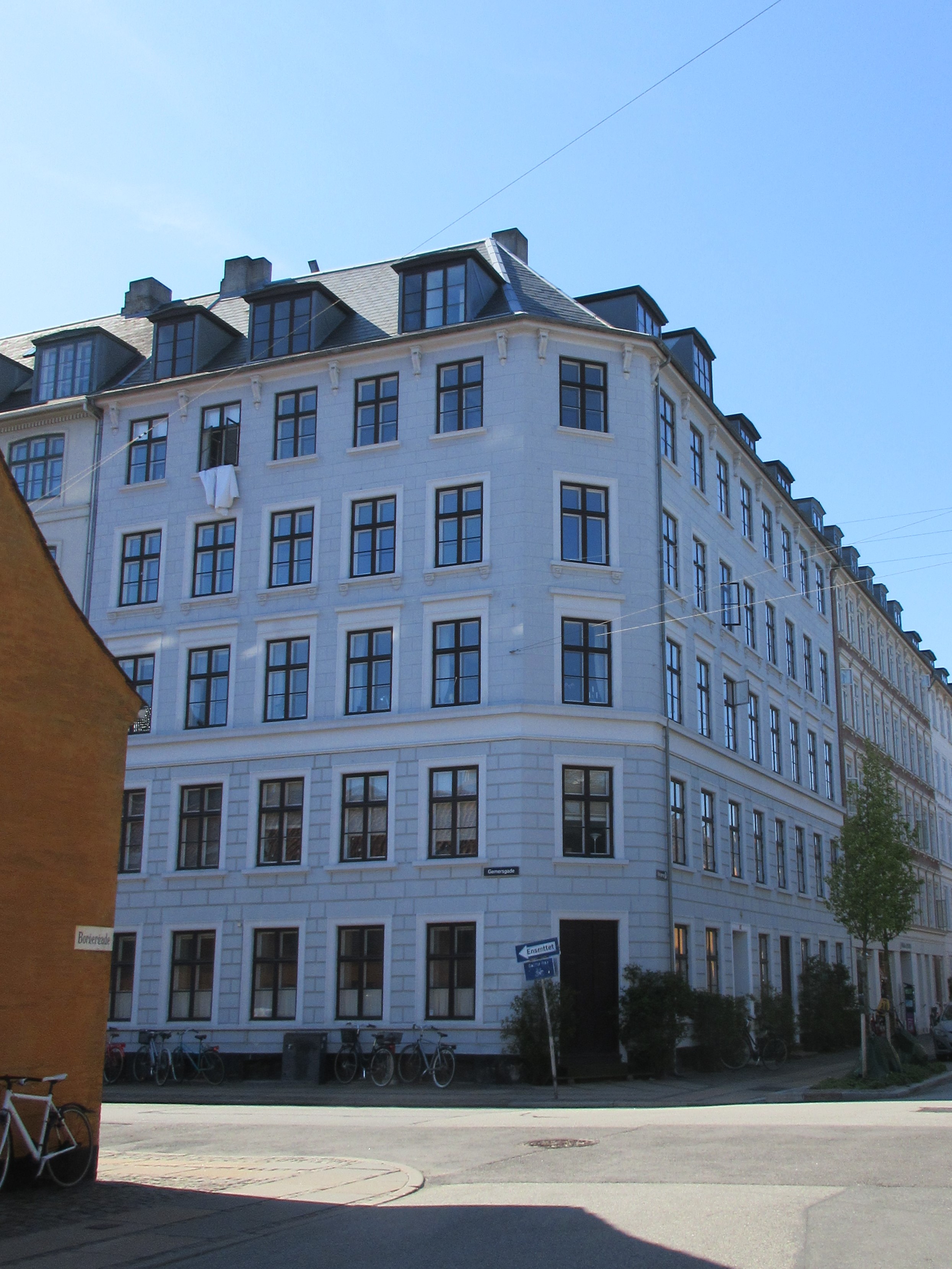Gernersgade 01 on:
[Wikipedia]
[Google]
[Amazon]
Gernersgade is a street in the Nyboder Quarter of central
 Gernersgade traces its history back to Christian IV's foundation of the Nyboder naval barracks in 1631 but different sections of it were originally known under individual names. The section from Store Kongensgade to Borgergade is on Gedde's district map of Sankt Annæ Vestre Kvarter called Hinde Længden (The Doe Row) while the section from Borgergade to Adelgade was called Gamle Gade (Old Street) and the section from Adelgade to Rigensgade is called Meriangade /Marjoram Street). Two of the names follow the general naming practice of Nyboder where the streets in the eastern part of the quarter is named after animal species and streets in the western part is named after herbs and medical plants.
Hinde Længden was later renamed Nygade (New Street) while Gamlegade was renamed Kanelgade (Cinnamon Street). In 1859 Nygade was renamed Gernersgade to commemorate the naval officer and shipbuilder
Gernersgade traces its history back to Christian IV's foundation of the Nyboder naval barracks in 1631 but different sections of it were originally known under individual names. The section from Store Kongensgade to Borgergade is on Gedde's district map of Sankt Annæ Vestre Kvarter called Hinde Længden (The Doe Row) while the section from Borgergade to Adelgade was called Gamle Gade (Old Street) and the section from Adelgade to Rigensgade is called Meriangade /Marjoram Street). Two of the names follow the general naming practice of Nyboder where the streets in the eastern part of the quarter is named after animal species and streets in the western part is named after herbs and medical plants.
Hinde Længden was later renamed Nygade (New Street) while Gamlegade was renamed Kanelgade (Cinnamon Street). In 1859 Nygade was renamed Gernersgade to commemorate the naval officer and shipbuilder
 The Nyboder houses that now line part of the street do not date from Christian IV's time but are later models. The yellow, two-storey terrace at No. 2-18 is an example of the houses that now dominate the quarter. They date from the 1750s and were designed by
The Nyboder houses that now line part of the street do not date from Christian IV's time but are later models. The yellow, two-storey terrace at No. 2-18 is an example of the houses that now dominate the quarter. They date from the 1750s and were designed by 
Gernersgade
at indenforvoldene.dk Streets in Copenhagen
Copenhagen
Copenhagen ( or .; da, København ) is the capital and most populous city of Denmark, with a proper population of around 815.000 in the last quarter of 2022; and some 1.370,000 in the urban area; and the wider Copenhagen metropolitan ar ...
, Denmark
)
, song = ( en, "King Christian stood by the lofty mast")
, song_type = National and royal anthem
, image_map = EU-Denmark.svg
, map_caption =
, subdivision_type = Sovereign state
, subdivision_name = Danish Realm, Kingdom of Denmark
...
. It runs from Store Kongensgade in the southeast to Rigensgade
Rigensgade ( lit. "State Street") is a street in central Copenhagen, Denmark. It links Sølvgade in the west with Øster Voldgade in the east. An underpass for pedestrians link the beginning of the street with Rosenborg Castle Gardens on the other ...
in the northwest and is closed to through traffic at Sankt Pauls Plads.
History
 Gernersgade traces its history back to Christian IV's foundation of the Nyboder naval barracks in 1631 but different sections of it were originally known under individual names. The section from Store Kongensgade to Borgergade is on Gedde's district map of Sankt Annæ Vestre Kvarter called Hinde Længden (The Doe Row) while the section from Borgergade to Adelgade was called Gamle Gade (Old Street) and the section from Adelgade to Rigensgade is called Meriangade /Marjoram Street). Two of the names follow the general naming practice of Nyboder where the streets in the eastern part of the quarter is named after animal species and streets in the western part is named after herbs and medical plants.
Hinde Længden was later renamed Nygade (New Street) while Gamlegade was renamed Kanelgade (Cinnamon Street). In 1859 Nygade was renamed Gernersgade to commemorate the naval officer and shipbuilder
Gernersgade traces its history back to Christian IV's foundation of the Nyboder naval barracks in 1631 but different sections of it were originally known under individual names. The section from Store Kongensgade to Borgergade is on Gedde's district map of Sankt Annæ Vestre Kvarter called Hinde Længden (The Doe Row) while the section from Borgergade to Adelgade was called Gamle Gade (Old Street) and the section from Adelgade to Rigensgade is called Meriangade /Marjoram Street). Two of the names follow the general naming practice of Nyboder where the streets in the eastern part of the quarter is named after animal species and streets in the western part is named after herbs and medical plants.
Hinde Længden was later renamed Nygade (New Street) while Gamlegade was renamed Kanelgade (Cinnamon Street). In 1859 Nygade was renamed Gernersgade to commemorate the naval officer and shipbuilder Henrik Gerner
Henrik Gerner (1742–1787) was a Danish naval officer who specialised in shipbuilding and naval architecture. His interests as an entrepreneurial engineer led to unsinkable gun platforms, horse-driven dredging machines, and desalination equipmen ...
. Kanelgade and Meriangade was included in Gernersgade in 1893.Notable buildings and residents
Philip de Lange
Philip de Lange (c. 1705 – 17 September 1766) was a leading Dutch-Danish architect who designed many different types of building in various styles including Dutch Baroque and Rococo.
Early life and family
Philip de Lange was probably born ...
. The terraces at No. 17-31 and No. 24-44 are examples of the so-called Grey Rows that were built between 1886 and 1893 to design by Olaf Schmidt with inspiration from Arbejdernes Byggeforening's building society houses.

Bygningskulturens Hus
Bygningskulturens Hus (English House of Architectural Heritage), the former Søetatens Pigeskole (English: The Naval Girls' School), is a listed Historicist building now serving as a centre for historic architecture and cultural heritage in Copenh ...
, a centre dedicated to historic architecture, is located at the corner with Borgergade. The building was originally constructed as a girls' school for daughters of personnel of the Royal Danish Navy but was later converted into a naval cadet academy and then army barracks. Realea (now Realdania Byg) acquired the building in 2003 and it was subsequently put through a comprehensive refurbishment which adapted it to its current use.
The building at the opposite corner with Borgergade (Borgergade 144) is from 1854 and was possibly designed by Peter Christoph Hagemann
Peter Christoph Hagemann (20 March 1810 – 22 August 1853), often referred to as P. C. Hagemann was a Neoclassical Danish architect who worked in Copenhagen.
Early life and education
Hagemann was born in Itzehoe in 1810, the son of mason Johann ...
. It was listed on the Danish Registry of Protected Buildings and Places in 1978.
The townhouses at No. 49-67 were built in 1870-72 by Frederik Bøttger for Arbejdernes Byggeforening to provide affordable, good-quality homes for workers at the B&W shipyard. More of the same type of houses are located in the neighbouring street Krussemyntegade. St. Paul's Church, whose chancel faces Gernersgade, is from 1877 and was designed by Johannes Emil Gnudtzmann
Johannes Emil Gnudtzmann (17 November 1837 – 14 April 1922) was a Danish architect working in the Historicist style. His most notable works are St. Paul's Church and the extension of the Royal Veterinary and Agricultural University's main ...
.
References
External links
{{CommonsGernersgade
at indenforvoldene.dk Streets in Copenhagen